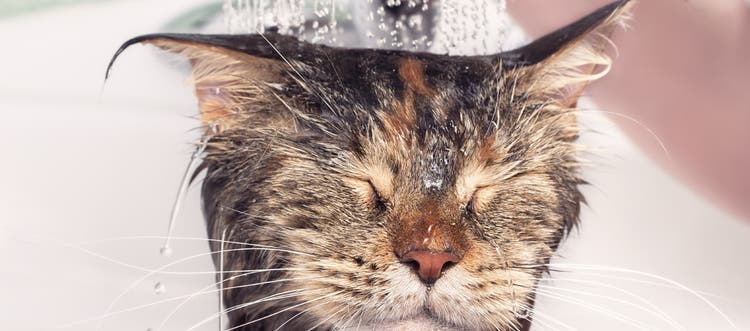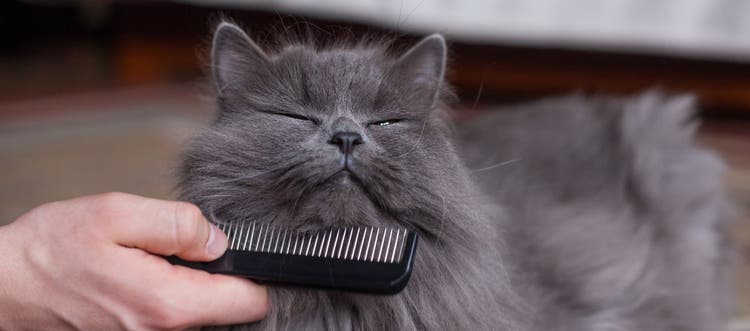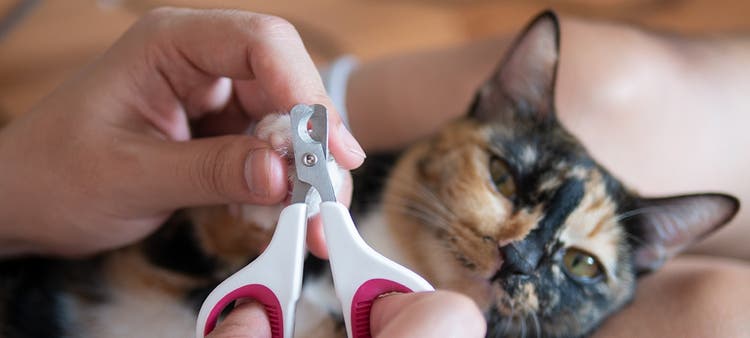The do’s and don’ts of cat baths.
Cats infamously hate water and baths — at least, according to cartoons and comic strips. But if you’ve ever left your sink or tub running and watched your cat bat at the stream of water, you know cats may not be as water averse as we think. This is good news for cat owners who find themselves needing to give their cat a bath. Read on to learn why your cat may need a bath and how to bathe your cat — without the hissing and scratching you may expect.
Do I Need to Bathe My Cat?
In general, cats keep themselves clean with regular self-grooming. But you may find yourself needing to give your cat a bath if your cat:
- Got into something smelly
- Is older and has trouble grooming themselves
- Is obese and has hard-to-reach spots
- Has another medical condition that might require some extra help with hygiene
- Has a flea infestation
How to Bathe Your Cat
1. Prepare for the Cat Bath
Careful preparation can help you avoid painful scratches from an unhappy kitty. Before you start the bath, make sure to gather your supplies, including a pet-friendly shampoo for your cat, a washcloth, a plastic pitcher or large cup for pouring water, a non-slip bath mat and your cat's favorite treats for rewards afterward.
Do:
- Trim your cat’s claws to protect your hands and arms.
- Brush your cat’s coat and any matted fur before getting it wet to keep the bathing process quick and pain-free. Scissors should only be used as a last resort for removing matted fur, as it’s easy to accidentally cut skin.
- Put down a non-slip surface like a rubber mat to prevent your cat from sliding around.
- Let your cat explore the tub or sink without any water, getting them comfortable with the space.
- Enlist a helper if possible.
Don’t:
- Even think about skipping this step! Preparing your cat and the bathing area ahead of time will help you stay calm and in control of the situation.
2. Bathe and Shampoo
So how do you bathe a cat? Follow these steps:
- Run 4 or 5 inches of lukewarm water, setting some aside in your cup or pitcher.
- Carefully wet the area around your cat’s neck with your hands. Try to keep your cat’s head dry for as long as possible — soaking them is the quickest way to induce panic!
- After wetting your cat’s neck, introduce your cat to the water, talking to them calmly.
- Gently pour warm water over your cat’s body with the plastic pitcher or cup rather than hosing them with the shower spray.
- Once your cat is completely wet, apply the shampoo from the neck down to the end of their tail, avoiding the face and ears. Lather the shampoo gently in the direction of the fur as if you were stroking your cat, making sure to cover their underside.
- Use a washcloth with plain water to carefully clean your cat’s face, being sure to avoid getting water in their ears.
Do:
- Use a shampoo that is formulated for pets.
- Keep your voice low and soothing.
- Work quickly and calmly — the sooner your cat is out of the water, the happier they will be.
Don’t:
- Ignore your cat’s high-stress signs. If your pet seems extremely stressed, stop immediately. This will help limit the stress to your cat and keep your relationship healthy and full of trust.
3. Rinse and Dry
After shampooing, rinse your cat thoroughly using the warm water set aside in your pitcher. Keeping your cat in a small, draft-free space will help as you dry them. Some cats enjoy being swaddled in a warm towel, while others may prefer to be left alone after their bath. If your cat is long-haired, you will also need to brush out any fur that might have gotten tangled during the bathing process.
Do:
- Continue to work calmly and quickly. You’re nearly finished!
- Reward your cat with lots of praise and a treat — they’ve earned it.
Don’t:
- Use a hair dryer — they’re too hot and noisy.
Flea Baths for Cats
Parasite infections like fleas can cause cats extreme irritation, leading them to overgroom and making them vulnerable to infection, skin allergies and anemia. If you find fleas on your cat, a flea treatment product can kill fleas on contact. However, for cats with severe flea infestations or flea allergy dermatitis, a flea bath with a treatment cat shampoo might also be needed.
If you’re bathing your cat to help tackle a flea infestation, the same principles and approach outlined below apply. However, make sure to read the flea shampoo's label to find out additional information that may be specific to it, such as frequency of use and the minimum age a cat needs to be before use.
Using regular flea treatment on your cat — available in forms such as collars and topicals — can help protect them against an infestation and avoid another trip to the shower.
When you need to help your cat stay clean, taking the time to make the bath a comfortable experience for your pet will also help keep you safe from scratches and bites. Your happy, clean cat will be grateful.
Related Articles

New Cat or Kitten: Our Downloadable Guide
Thinking about adding a feline to the family? There are so many emotional, social and physical benefits to owning a cat. Check out our free guide, also available to download!







